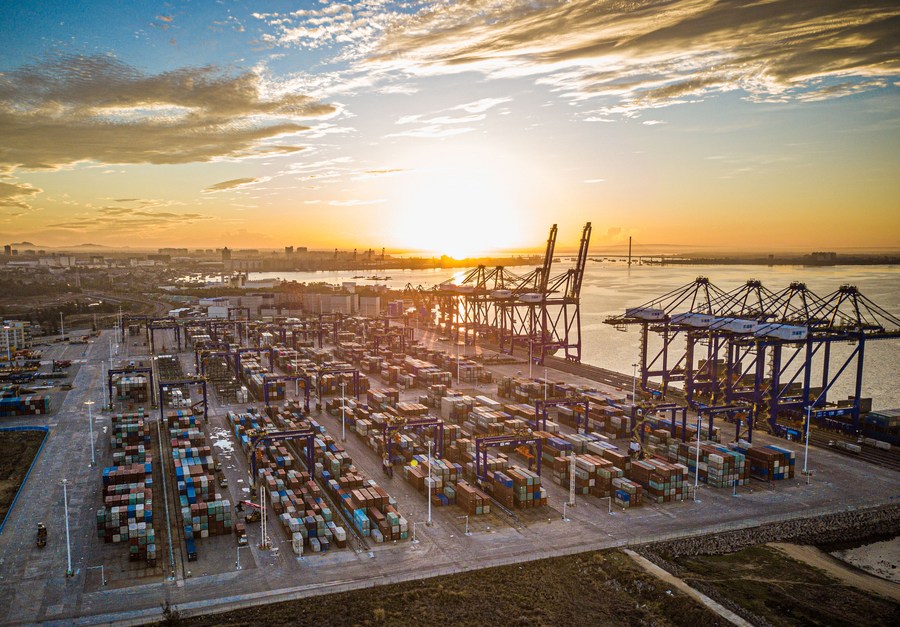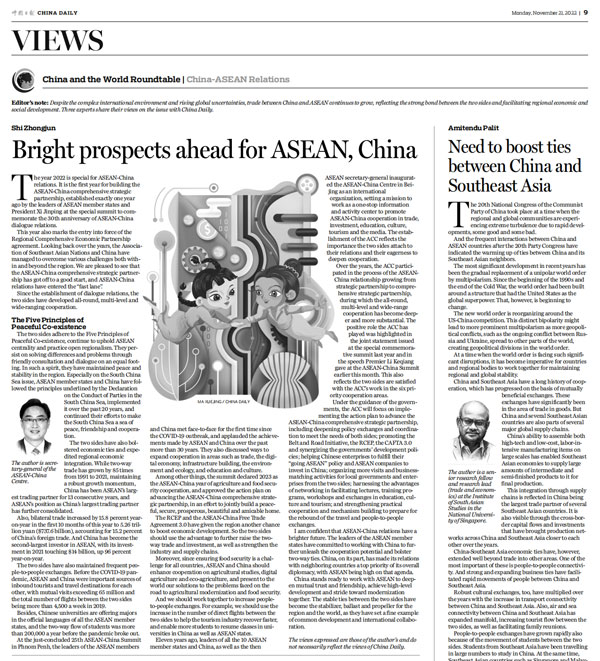
Editor's note: Despite the complex international environment and rising global uncertainties, trade between China and ASEAN continues to grow, reflecting the strong bond between the two sides and facilitating regional economic and social development. Three experts share their views on the issue with China Daily.
Bright prospects ahead for ASEAN, China
The year 2022 is special for ASEAN-China relations. It is the first year for building the ASEAN-China comprehensive strategic partnership, established exactly one year ago by the leaders of ASEAN member states and President Xi Jinping at the special summit to commemorate the 30th anniversary of ASEAN-China dialogue relations.
This year also marks the entry into force of the Regional Comprehensive Economic Partnership agreement. Looking back over the years, the Association of Southeast Asian Nations and China have managed to overcome various challenges both within and beyond the region. We are pleased to see that the ASEAN-China comprehensive strategic partnership has got off to a good start, and ASEAN-China relations have entered the "fast lane".
Since the establishment of dialogue relations, the two sides have developed all-round, multi-level and wide-ranging cooperation.
The Five Principles of Peaceful Co-existence
The two sides adhere to the Five Principles of Peaceful Co-existence, continue to uphold ASEAN centrality and practice open regionalism. They persist on solving differences and problems through friendly consultation and dialogue on an equal footing. In such a spirit, they have maintained peace and stability in the region. Especially on the South China Sea issue, ASEAN member states and China have followed the principles underlined by the Declaration on the Conduct of Parties in the South China Sea, implemented it over the past 20 years, and continued their efforts to make the South China Sea a sea of peace, friendship and cooperation.
The two sides have also bolstered economic ties and expedited regional economic integration. While two-way trade has grown by 85 times from 1991 to 2021, maintaining a robust growth momentum, China has been ASEAN's largest trading partner for 13 consecutive years, and ASEAN's position as China's largest trading partner has further consolidated.
Also, bilateral trade increased by 15.8 percent year-on-year in the first 10 months of this year to 5.26 trillion yuan ($737.6 billion), accounting for 15.2 percent of China's foreign trade. And China has become the second-largest investor in ASEAN, with its investment in 2021 touching $14 billion, up 96 percent year-on-year.
The two sides have also maintained frequent people-to-people exchanges. Before the COVID-19 pandemic, ASEAN and China were important sources of inbound tourists and travel destinations for each other, with mutual visits exceeding 65 million and the total number of flights between the two sides being more than 4,500 a week in 2019.
Besides, Chinese universities are offering majors in the official languages of all the ASEAN member states, and the two-way flow of students was more than 200,000 a year before the pandemic broke out.
At the just-concluded 25th ASEAN-China Summit in Phnom Penh, the leaders of the ASEAN members and China met face-to-face for the first time since the COVID-19 outbreak, and applauded the achievements made by ASEAN and China over the past more than 30 years. They also discussed ways to expand cooperation in areas such as trade, the digital economy, infrastructure building, the environment and ecology, and education and culture.
Among other things, the summit declared 2023 as the ASEAN-China year of agriculture and food security cooperation, and approved the action plan on advancing the ASEAN-China comprehensive strategic partnership, in an effort to jointly build a peaceful, secure, prosperous, beautiful and amicable home.
The RCEP and the ASEAN-China Free Trade Agreement 3.0 have given the region another chance to boost economic development. So the two sides should use the advantage to further raise the two-way trade and investment, as well as strengthen the industry and supply chains.
Moreover, since ensuring food security is a challenge for all countries, ASEAN and China should enhance cooperation on agricultural studies, digital agriculture and eco-agriculture, and present to the world our solutions to the problems faced on the road to agricultural modernization and food security.
And we should work together to increase people-to-people exchanges. For example, we should use the increase in the number of direct flights between the two sides to help the tourism industry recover faster, and enable more students to resume classes in universities in China as well as ASEAN states.
Eleven years ago, leaders of all the 10 ASEAN member states and China, as well as the then ASEAN secretary-general inaugurated the ASEAN-China Centre in Beijing as an international organization, setting a mission to work as a one-stop information and activity center to promote ASEAN-China cooperation in trade, investment, education, culture, tourism and the media. The establishment of the ACC reflects the importance the two sides attach to their relations and their eagerness to deepen cooperation.
Over the years, the ACC participated in the process of the ASEAN-China relationship growing from strategic partnership to comprehensive strategic partnership, during which the all-round, multi-level and wide-range cooperation has become deeper and more substantial. The positive role the ACC has played was highlighted in the joint statement issued at the special commemorative summit last year and in the speech Premier Li Keqiang gave at the ASEAN-China Summit earlier this month. This also reflects the two sides are satisfied with the ACC's work in the six priority cooperation areas.
Under the guidance of the governments, the ACC will focus on implementing the action plan to advance the ASEAN-China comprehensive strategic partnership, including deepening policy exchanges and coordination to meet the needs of both sides; promoting the Belt and Road Initiative, the RCEP, the CAFTA 3.0 and synergizing the governments' development policies; helping Chinese enterprises to fulfill their "going ASEAN" policy and ASEAN companies to invest in China; organizing more visits and business-matching activities for local governments and enterprises from the two sides; harnessing the advantages of networking in facilitating lectures, training programs, workshops and exchanges in education, culture and tourism; and strengthening practical cooperation and mechanism building to prepare for the rebound of the travel and people-to-people exchanges.
I am confident that ASEAN-China relations have a brighter future. The leaders of the ASEAN member states have committed to working with China to further unleash the cooperation potential and bolster two-way ties. China, on its part, has made its relations with neighboring countries a top priority of its overall diplomacy, with ASEAN being high on that agenda.
China stands ready to work with ASEAN to deepen mutual trust and friendship, achieve high-level development and stride toward modernization together. The stable ties between the two sides have become the stabilizer, ballast and propeller for the region and the world, as they have set a fine example of common development and international collaboration.
The author Shi Zhongjun is secretary-general of the ASEAN-China Centre.
